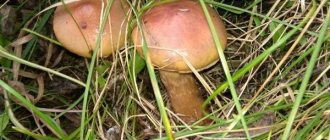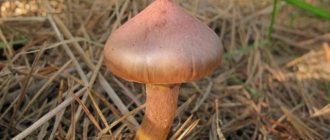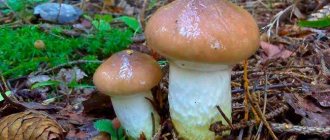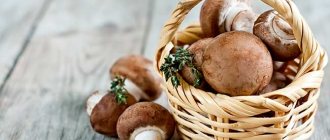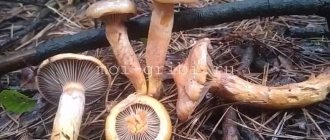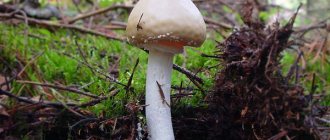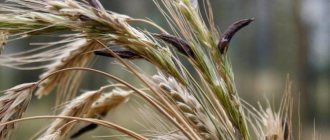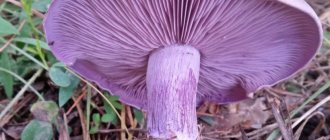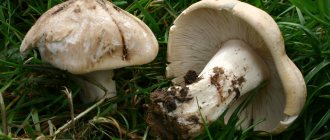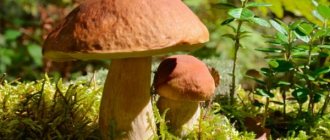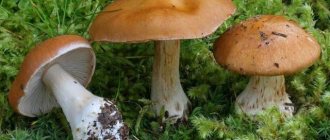In Russian forests we are surrounded by unprecedented, incredible, beautiful mushrooms. One of the most unusual is mokrukha. Very often it is undeservedly missed, and all because it does not have a very edible appearance, specific color and structure.
It is often kicked around, and yet this is just the mushroom that will decorate your table, perhaps becoming part of your favorite family dish.
Spruce moth or sticky moth, also known as slug mushroom, is difficult to confuse with something else. It has such a specific appearance that they decided to devote a separate article to this mushroom.
Description and photo of spruce weed
As mentioned above, the specific appearance of spruce weevil repels mushroom pickers from it. Many people believe that fungi are poisonous. We will return to the question of the benefits of this mushroom, but for now we will find out the nuances of its appearance and structure.
From Latin - Gomphidius glutinosus.
hat
The hat is the most remarkable thing that a mushroom picker might notice first. Spruce makruha has a non-standard beige or brown tint, which is characteristic of a large number of mushrooms. It is brown with a purple tint, like an eggplant. However, depending on the composition of the soil, as well as on the place where the fungus grows, the color may vary, being more brown or, conversely, bright purple.
The cap of the mushroom is semicircular, at first it is convex, resembling a hemisphere, then, with age, it begins to straighten out. It becomes like a circle, with a center pressed in in the middle.
The diameter of the cap around it could reach up to 12 cm, but most often there are individuals whose diameter does not exceed 7 or 8 cm. If you press on the cap, you will feel how dense and fleshy it is, but with age it becomes more rubbery, the mushroom is difficult divide into parts, and the mushroom smell ceases to thin out from the pulp.
Records
The plates were neatly arranged under the cap. If we compare them with other mushrooms, we can note that they are quite rare, well branched, but at the same time very brittle and completely fragile. At the beginning of growth, the color of the plates is beige or white, then it becomes beige, and then darkens to almost a dark color.
The plates are not dry, covered with transparent mucus, less often with an admixture of white tint. It slowly flows down the legs, freezing in drops.
The spore powder, which is hidden inside the plates, has a dark brown tint. Less often, black. Very light, homogeneous structure.
Leg
In order to support such weight, the moth's cap needs a stable and durable leg. The mokrukha's is really massive. It reaches 12 cm in length, and up to 3 cm in diameter. The leg has a cylindrical shape, like a column, it is thick at the base, thinning out quite a bit closer to the cap. Very durable, it can withstand not only the wetness itself, but also the leaves that have fallen on it.
Very often a ring of mucus forms on the leg, but after the first rain it disappears. If we cut the flesh of the leg, we will see that it has a yellow tint, less often beige. In old mushrooms, the flesh becomes yellow and hard, not at all soft. Over time, the leg becomes hollow.
If the ring on the stem is never washed off by rain, then over time it darkens. This is where the process of decay of the mushroom begins.
Pulp
Mokruha is famous precisely because of its pulp. It is tasty, pleasant and looks quite neat. When cut, the mushroom has a white tint and milky juice is released from it. When exposed to oxygen, the pulp becomes slightly yellower.
It has a pronounced mushroom aroma and pleasant taste. Worms love to feast on these mushrooms, so they often settle inside the cap.
Edibility
There is a lot of information about the edibility of moth, and each one contradicts the other. For example, in the European part of the continent it is believed that morukha is an edible mushroom. It is used in various dishes and even as a delicacy.
Mokruha is freely consumed in Switzerland, England, Germany, Denmark and Norway. In Canada and the United States, where this mushroom is also present, it is believed that it is better not to eat it, as cases of poisoning have been recorded.
As for Russia, the attitude towards the mushroom is ambiguous. In general, it has been awarded the title of edible. However, many continue to bypass it. Some people are frightened by the too bright appearance of the wet woman. Others say that they have become familiar with its composition and do not see any substances useful to the human body. Still others complain that after drinking the flu they felt their stomach churn. It is unknown who to believe. However, mokrukha is an edible mushroom in Russia. But still, pregnant women, breastfeeding women, people with diseases of the gastrointestinal tract, as well as children under the age of 14 should be wary and better refrain from using it.
Spruce weed is on Wikipedia.
Titles
Synonyms:[1]
- Agaricus glutinosus Schaeff., 1774basionym
- Agaricus adhaerens JF Gmel., 1792
- Agaricus fuscus Batsch, 1783
- Gomphus glutinosus (Schaeff.)
- Leucogomphidius glutinosus Kotlába & Pouzar, 1972
- Agaricus mitratus JF Gmel., 1792
- Myxacium mucosum P. Kumm., 1871
- Agaricus mucosus Bull., 1812
Russian synonyms: sticky mokrukha, slug.
The generic name of the mushroom comes from the Greek γομφος/gomphos “molar tooth, peg”; specific epithet - from the Latin glutinosus
"adhesive".
Similar species
Despite the fact that the wet fly can rarely be confused with anything else, there are still species that are similar to it in external characteristics.
Mokrukha spotted
Very similar to spruce, however, in addition to the eggplant shade, the cap also has characteristic spots that are concentrated in the very center. The difference is that the flesh of the spotted fly has a bright pink or reddish tint. This mushroom is not poisonous, but its nutritional properties are very mediocre.
Wet purple
Another mushroom, which in the shape and color of the cap is very similar to its famous brother. However, the leg of the purple moth has a reddish or orange tint. This is the main difference between these two mushrooms and each other.
Oiler
Mokrukha is often confused with boletus mushrooms, largely because both mushrooms carefully collect a glossy covering on their cap. Glossy surfaces are similar, the differences in color are slightly invisible.
However, the oiler has a tubular layer above its cap, while the mokrukha has a lamellar one.
Recipes
This is a little-known edible mushroom that is suitable for culinary processing. Butternuts have similar taste properties. In preparation for cooking, it is necessary to remove mucus from the surface. Heat treatment changes the color of the mushroom to purple. It has a number of useful properties.
The species contains useful elements for the human body that can improve memory, eliminate chronic fatigue and strengthen the body's defenses. It also helps fight viruses and bacteria, promoting proper blood formation, and helps cells regenerate and renew.
Sometimes traditional medicine uses this specimen as a medicine for headaches and insomnia, as well as in medicines to combat nervous system disorders.
Bachelor sandwich
Very simple and quick recipe.
You will need:
- Bread – 2 pieces, fried in a frying pan in oil.
- Fresh wet fruits – 10-15 pcs.
- Hard cheeses – 10 g.
- Butter – 1 tbsp. l.
- Greens to taste and preference.
Stages:
- We clean the mushrooms from mucus and the upper surface, remove dirt and damaged parts. Carefully wash and cut into small slices. We cut large specimens into smaller pieces.
- Cut the pulp into small slices and place in a dry frying pan, after which we give the forest product time to evaporate. This will take approximately 4-5 minutes.
- Add butter and continue frying for 6-7 minutes.
- Grease the fried slices of bread with butter, then spread the prepared mushroom products in thin layers. Sprinkle the herbs and cheese on top in the amount required by the cook.
- Place the sandwich in the microwave to melt the cheese.
Mokruhi in Korean
You will need:
- Representatives of the mushroom kingdom – 1 kg.
- Onions – 2 pcs.
- Korean carrots – 0.2 kg.
- Sunflower oil – 2-3 tbsp. l.
Stages:
- We clean the mushrooms from mucus and the upper surface, remove dirt and damaged parts. Carefully wash and cut into small slices. Place in a container and boil for 13-14 minutes. Make the fire medium.
- Strain and remove unnecessary liquid and moisture, cut the pulp into small cubes.
- Place the mixture in a frying pan and fry for about 8-10 minutes.
- We get a dressing to which we need to add Korean carrots. Very simple and quick recipe.
Omelette
A very tasty dish that will help you please yourself and your family. It prepares very quickly and requires a minimum of effort. Contains alcohol.
You will need:
- Prunes – 0.15 kg.
- Semi-dry or other wine – 0.15 l.
- Tomatoes – 1 pc.
- Chicken eggs – 5-6 pcs.
- Greens to taste.
Stages:
- We clean the mushrooms from mucus and the upper surface, remove dirt and damaged parts. Carefully wash, cut into small slices and fry until the liquid evaporates.
- Pre-soak the prunes. Then we chop it and add it to the main mass.
- We wait a few minutes and pour alcohol or wine into the frying pan and simmer until it completely evaporates.
- Cut the tomatoes into small pieces and add to the preparation. Salt and pepper according to individual preferences.
- Beat a lot of chicken eggs with a whisk and add a little baking powder.
- The eggs must be poured into the main mass, gradually stirring.
- The container should stand on the fire for about 7 minutes. As you can see, this is a very simple and quick recipe.
- After all, you need to decorate the dish with herbs to taste.
Where and at what time does it grow?
Where can you see this wonderful mushroom, which is so unlike any other? Mokrukha loves to settle in coniferous forests. Its habitat is considered to be the central zone of Russia, less often the northern part. Mokruha rarely gets to the south.
It can also be found in Europe, the CIS countries, the United States of America and Canada.
Rarely do fungi enter into mycorrhiza with coniferous trees; most often they prefer spruce or pine trees.
Mokrukha likes to settle in old spruce forests where there is rotting wood. These are ideal conditions for its growth.
It prefers moderately warm weather, but can hardly tolerate temperatures above 25°. Also does not like extreme cold. It can be found not only in spruce forests, but also in open meadows and alleys.
Mokrukha has an amazing feature. Like any other mushroom that settles in areas located near highways, contaminated lands, and industrial enterprises, it absorbs toxins and harmful substances. However, unlike other mushrooms, morukha begins to turn yellow immediately and dies over time. Therefore, a person is unlikely to eat a mushroom contaminated with toxins.
Article on the topic - Spotted weed (Gomphidius maculatus): edible mushroom of category 4 with photo.
Links
- Spruce weed on the website [www.ecosystema.ru/08nature/fungi/116.htm “Ecosystem”].
- Spruce weed on the website [mycoweb.narod.ru/fungi/Gomphidius_glutinosus.html “Mushrooms of the Kaluga Region”].
- Spruce weed on the website [www.foresterfaq.spb.ru/index.php?option=com_sobi2&sobi2Task=sobi2Details&sobi2Id=65&Itemid=41 “Mushrooms of the Leningrad Region”].
- Spruce weed on the website [www.toadstool.ru/spisok-rodov/gomphidius/gomphidius-glutinosus/ “We, mushrooms”].
- Spruce damp on the website [www.rogersmushrooms.com/gallery/DisplayBlock~bid~5962~source~gallerychooserresult.asp RogersMushrooms].
Benefit and Harm
Despite its specific appearance, the mushroom is very useful. This fact proves that it is very often used in folk medicine. For example, there are recipes that use mokrukha and use it to increase immunity, tone the body, and stop bleeding.
Mokrushechka is very useful for people with low immunity, as well as diseases of the musculoskeletal system.
It contains amino acids that are beneficial for the nervous system, as well as appearance.
In ancient times, a powder was made from spruce moth, which girls used by adding water. It was believed that it imparts youth, freshness and beauty.
But do not underestimate the harm from this mushroom. For example, it can cause a severe allergic reaction. It contains substances that are not tolerated by the body. And finally, consuming worm-eaten mucus can have a negative impact on your health.
Notes
- From the site [www.mycobank.org/MycoTaxo.aspx?Link=T&Rec=168636 Mycobank.org]
- Sergeeva M. N.
Mushrooms. - M.: “Culture and Traditions”, 2003. - P. 52. - 264 p. — ISBN 5-86444-080-9. - Ratova M.R., Kutafyeva N.P.
Spruce moth (Gomphidius glutinosus (schaef. ex. fr.) fr. var. glutinosus) and purple moth (Chroogomphus rutilus (schaef. ex. fr.) ok miller) are little-known species in the groups of edible mushrooms of the Pogorelsky pine forest (Krasnoyarsk Territory) / / Conifers of the boreal zone. - Siberian State Technological University, 2009. - T. XXVI, No. 1. - P. 134-137. - Schaeffer, JC
Fungorum qui in Bavaria et Palatinatu Nascuntur Icones, Volume: 4. - 1774. - pp. 1-136. - Fries, E.
Epicrisis Systematis Mycologici. - 1838. - P. 1-610.
Contraindications
Slugs are edible mushrooms, and it is impossible to get poisoned by this product. But to avoid unnecessary health problems, you must follow some rules:
- do not collect mushrooms in places with unfavorable ecology, near garbage dumps and industrial facilities;
- Avoid eating for people suffering from diseases of the digestive system;
- do not give to children under 5-6 years old;
- Avoid consumption for those who have undergone complex operations or serious illnesses.
Collection rules
To avoid negative consequences, it is important to adhere to the basic rules for collecting moth:
- The cut of the mushroom must be made in the middle of the stem, then cover the mycelium with pine needles.
- It is strictly not recommended to collect moths near highways, military training grounds or chemical plants.
- It is best to give preference to young specimens, since old mushrooms tend to accumulate toxic substances.
- It is equally important to check the fruiting body for worms.
- Immediately after collection, it is important to heat-treat the mushrooms: at room temperature, the mushrooms quickly deteriorate.
- Can be stored in the refrigerator for no more than 24 hours. In this case, the fruiting bodies should be kept in clay or enamel containers.
